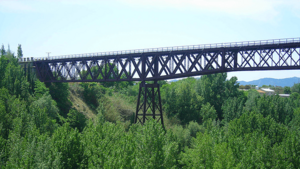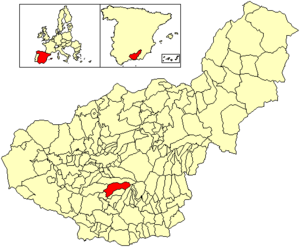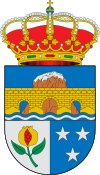Dúrcal facts for kids
Quick facts for kids
Dúrcal
|
||
|---|---|---|

Lata Bridge, in Dúrcal
|
||
|
||
 |
||
| Country | Spain | |
| Province | Granada | |
| Comarca | Lecrín Valley | |
| Area | ||
| • Total | 76 km2 (29 sq mi) | |
| Elevation | 782 m (2,566 ft) | |
| Population
(2018)
|
||
| • Total | 6,975 | |
| • Density | 91.8/km2 (237.7/sq mi) | |
| Website | www.adurcal.com | |
Dúrcal is a town in Spain, located in the Province of Granada. It's part of the beautiful Valle de Lecrín, which is a valley near the big city of Granada. Dúrcal is surrounded by other towns like Dílar, Lanjarón, Nigüelas, Villamena, and Padul. The main parts of Dúrcal are the town itself and a smaller area called Marchena. A big part of Dúrcal is even inside the amazing Sierra Nevada National Park!
Contents
History of Dúrcal
Early Settlers
People have lived in the Dúrcal area for a very long time. We know this because archaeologists have found tools and pottery from about 4500 BC. This was during the Neolithic Age, also known as the New Stone Age. These finds show that Dúrcal was a natural path between the Mediterranean coast, the Alpujarra mountains, and the Granada area.
Later, different groups of people came to Dúrcal. Some came from the Middle East looking for metals. Then came the Phoenicians, Greeks, Carthaginians, and Romans. The Romans left behind many interesting items. You can see these ancient Roman artifacts in museums nearby.
Moorish Era
Not much is known about Dúrcal between the Roman times and the arrival of the Moors. But from the 700s to the 1400s, when the Moors ruled, Dúrcal became a busy farming center. They built forts and walled areas to protect the valley's paths. The villages grew citrus fruits and mulberry trees. Mulberry trees were important because their leaves were used to feed silkworms for silk production.
The name Dúrcal comes from this time. It was called Durkar in Arabic, but we don't know exactly what that means. Many important buildings were also constructed during this period.
After the Reconquest
In 1491, the Catholic Monarchs began to take back the area from the Moors. Much of what had been built in the Lecrín Valley was destroyed. By 1492, Granada was conquered, and the Moorish rule slowly ended.
After the Moors were expelled in 1571, Dúrcal's economy suffered. Farming and crafts stopped, and the number of people living there dropped a lot. In 1587, only 320 people lived in Dúrcal, and by 1730, there were only 160.
Modern Growth
During the 1800s and 1900s, Dúrcal's population slowly grew again. Farming also started to become important once more. In recent times, Dúrcal has grown in new ways. It now has industries and services, and it has become a popular place for rural tourism. This town, with its long and changing history, is now building a new future.
Rocío Dúrcal
A famous Spanish singer and actress named Rocío Dúrcal chose her stage name from this town. She picked Dúrcal randomly from a map of Spain. Because of this, the town made her an "adoptive daughter." The city council named a street after her and put up a statue of her in the main square, Plaza España.
See also
 In Spanish: Dúrcal para niños
In Spanish: Dúrcal para niños


